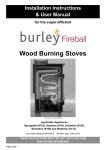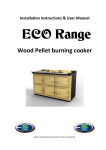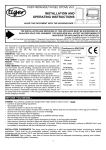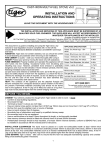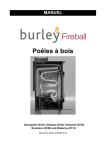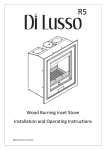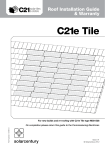Download Installation Instructions & User Manual
Transcript
Installation Instructions & User Manual for the super-efficient ᵌ Wood burning stoves Please retain these instructions for future reference. WARNING The Burley Turbo series of stoves are wood burning only (this includes logs, sawdust briquettes and pellets); no attempt should be made to burn any other fuel, including all types of coal, smokeless fuels and petroleum coke. Under no circumstances should liquid fuels be added. It is not an incinerator and rubbish included painted, tanalised wood and MDF should not be burnt in this appliance. Any attempt is dangerous and will invalidate any guarantees immediately. Technical data All built to EN13240 Small & Small DEFRA approved Medium & Medium Large DEFRA approved Efficiency 89.1% 85.5% 84.9% CO concentration 0.1% 0.1% 0.1% Dry Logs < 25% H²O Dry Logs < 25% H²O Dry Logs < 25% H²O 225 – 300mm long 225 – 350mm long 225 – 450mm long 95 kg 105 kg 130 kg 8kW 12 kW @13% Oxygen Fuel Weight in kg kW output intermittent 5kW Air vent requirement Not required unless house is less that 4 years old then: use manifold or 550mm sq. mm,30mm diameter 1650mm sq. mm 50mm diameter Unless connected using manifold 4,950mm sq. min 100mm diameter Unless connected using manifold Minimum flue draught mm H²O 0.5mm 0.5mm 0.5mm Flue gas temperature Spigot Temp. Flue size Min. chimney diameter Best chimney diameter Minimum distance to combustible materials Max. Hearth temp. Min. Hearth thickness 122 °C 241 °C 150mm (6”) 150mm (6”) 150mm (6”) 20cm behind (8”). 35cm at side (14”) <100 °C 12mm 183 ˚C 274 °C 150mm (6”) 150mm (6”) 150mm (6”) 10cm behind (4”). 40cm at side (16”) <100 °C 12mm 237 °C 316 °C 150mm (6”) 150mm (6”) 175mm (7”) 20cm behind (8”) 45cm at side (18”) <100 °C 12mm Installation Instructions When installing these appliances, all local regulations, including those referring to national & European Standards need to be complied with. This manual covers the appliances: Burley Turbo models small, medium & large. The nominal space heating output is: Small: 5Kw, Medium: 8Kw & Large: 12Kw. Any of the above appliances must be installed by a HETAS registered installer and the installation registered with the local council. Failure to comply with the above renders all guarantees and liabilities of the manufacturer null and void. The manufacturer will not guarantee or accept liability for any problem that arises unless, a HETAS installation commissioning certificate has been completed and a valid receipt or proof of purchase is presented from the approved supplier. The appliances should not be fitted closer than shown in the chart, from combustible materials, e.g. wooden fire surround or stud wall. When fitted against a wall made of combustible material e.g. a wooden stud wall with plasterboard, extra non-combustible material should be fitted behind the stove if the distance from the wall is less than shown unless a 75mm thick non combustible material is used as a barrier. When fitted inside a masonry or similar non-flammable material recess, e.g., fireplace opening, there is no minimum distance, the gaps are only an aesthetic consideration. Hearths The stove should stand on a non-combustible heath of minimum thickness 12mm (1/2”). This should extend a minimum 225mm (9”) in front of the stove. When a stove is free-standing, the hearth should also extend a minimum of 150mm (6”) either side of the stove. The hearth must be capable of taking the load of the appliance. Suitable measures, (e.g. a load distribution plate) should be taken if to ensure stability. Air supply All hydrocarbon burning appliances require an oxygen/air supply. If the chimney/stove is to be fitted on an external wall the air supply can be taken straight from the outside. A 3” (100mm) diameter hole needs to be drilled in the correct place, 138mm above the hearth and the stove ‘manifold/extension air pipe’ kit purchased and fitted. A proprietary grille is supplied with the kit, if not used an air brick or non-closing vent should be fitted to ensure the air supply is not blocked in any way. This method of supplying air is always to be preferred as there will be no draught in the room especially when the stove is not in use. If the stove is not on an outside wall or the direct air supply method cannot be used, an air vent must be supplied in the room in which the stove is fitted. The sizes of the vents required are: Small, 0- 550mm sq.(25mm diameter) Medium,1650mm sq.(50mm diam.) Large,4950mm Sq.(100mm diam.) Only permanently open vents can be used and consideration should be given to draught when the stove is not in use. Site these vent carefully. The vent covers should comply with Building Regulations Part J and should be sited where they cannot be blocked. Chimneys All 3 models require a chimney of minimum 6” diameter (150mm) and a minimum length of 4 metres and they must comply with Building Regulations J. Never share the flue with another appliance. Without a chimney to these specifications there could be insufficient draw on the chimney to pull sufficient oxygen through the appliance to make it burn properly. If you live in a valley or are surrounded by tall trees or buildings you might experience downdraught problems where the wind tries to stop the fumes rising up the chimney. An anti-downdraught cowl might help, but antidowndraught cowls reduce draw, so will not work on single storey chimneys and those with insufficient draw. We recommend you seek the advice of a HETAS or NACE registered supplier and installer before purchasing any stove or heating appliance. Assembly & installation of the stove fire bricks and baffle plates. Having positioned your Burley Turbo stove & connected it to a chimney with flue pipe, (we recommend 1mm stainless steel pipe sprayed matt black) you need to assemble the inside parts. There are 5 inside components, top and lower baffles, 2 side cheeks & a rear brick. Place the top baffle loosely in position resting on the back square steel columns. Place the left hand side brick in place, followed by the right hand. The top baffle can then be placed correctly and the rear brick inserted. Finally when these parts are snugly in position with the top baffle as far to the back as it will go, the lower stainless steel baffle can be positioned resting on the front ledge. When sweeping the chimney or carrying out regular maintenance on the stove, reverse the above procedure, clean the chimney and the top surface of the top baffle and the stainless steel mesh, then reposition all the components. Commissioning of the Thornhill Turbo Appliance On completion of the installation, when any fire cement or paint used has dried, the stove can be lit, a smoke ‘bomb’ should be burnt and all joints checked for smoke leakage and the chimney draw checked with all doors and windows closed. Please leave the instructions with the customer and inform them;- 1/ When they first light the fire, smoke will appear around the stove and flue pipe with a strong acrid smell. This is normal and is the paint curing. If the stove is fired properly for at least 2 hours this should not happen again. 2/ That they should fire it quite hard for at least half an hour every time the stove is lit, to warm the stove, flue pipe & chimney. It can then be turned down, but it will tar up and become less efficient if kept running at a low temperature. 3/ You cannot have wood fuel too dry, wood should be at about 20% maximum moisture content. Mixing wood that is 25% with manufactured logs @ 2-10% helps to keep the average moisture down and the stove working efficiently. 4/ Never empty all the ash, it is required to help keep the combustion chamber temperature up and an efficient clean burn. USER INSTRUCTIONS To light the Stove. It is important to keep an approximate minimum depth of ¾” (20mm) of wood ash in the fire box at any time. You will achieve this after the first few firings. Place 1 or 2 firelighters in the bottom, then some kindling wood criss-crossed diagonally, and finally 2 larger logs on top. Light the firelighters, open the air vent to maximum (to the right) and close the door to the first latch so there is an air gap around it. Leave it like this for at least five minutes and then add a further 2 logs. After about a further 5 minutes or so, the fire should be well alight, and the door can now be closed to become air tight. Leave the air control lever near the maximum (to the right) for a further 10 to 20 minutes to get the stove completely up to running temperature. The best running position to achieve maximum efficiency will depend on the chimney draw, but will be normally be near the centre. Every chimney is different, and you will find your stove’s optimum position. This is when the flames are swirling in a lazy manner around the stove, not roaring. If the lever is pushed too far to the left, you starve the fire of oxygen, causing the glass to darken. Move the lever a small amount to the right until the glass just stays clean. Once your stove is up to temperature, and you have found your optimum running position, it is best not to move it. The best way to run any wood stove is ‘little and often’, if you are around it is best to keep adding a small log (approximately 1kg) every 45 minutes rather than adding 4 large ones every 2 hours. THE STOVE IS NOT DESIGNED TO BE USED WITH THE DOOR OPEN To reload, open the air vent to the right, and then open the door slowly. Push some of the burning charcoal to the back of the combustion chamber and, using the gloves provided; place the fresh log towards the front of the appliance. Close the door and after 1 minute return the air slide to the central position. After being used 10 -20 times some ash might need to be removed. Never empty all the ash, leave at least ¾” (20mm) in the bottom. Ensure the fire is out before trying to remove any ash. Using the ash scoop provided, scrape back the top layer to one side and scoop out some of the lower ash. Place this on your compost heap or directly round fruit trees or rose bushes. Spread the remaining ash back evenly over the base of the stove and you are ready to relight the stove. Glass Simple glass cleaner will keep the stove glass fresh most of the time, with a proprietary stove glass cleaner being needed one a month or so to deep clean any stains. The stove is double glazed; check the rope seals and screws regularly to ensure a long life. In the event of a glass breakage, lift the door off and place on a flat surface. Undo the 4 screws holding the glass fixing brackets and place to one side. Remove the sheet of glass and clean the un-broken one. Check the door seal and replace if required. The seal/rope is ready glued, peel back the cover strip and push into place, cut to length using a sharp craft knife. Glue the second seal on the first pane of glass and place the second sheet over this. Replace and tighten the screws and brackets. Take care not to over tighten the screws. The glass has to expand and contract with each lighting. Chimney sweeping & Maintenance Your chimney should be swept at least once a year by a registered sweep, twice a year with heavy use. The sweep should also replace the fire cement at the base of the flue if necessary. The baffles should be removed in the reverse order described above. The chimney can be swept through the stove. The baffle should be cleaned at least twice a year with heavy use, checked, renewed as required and replaced. Under no circumstances should the stove be used with any baffle missing. All rope and glass seals should be checked annually and replaced as necessary. If the stove has not been used for a prolonged period, in excess of 6 months, the chimney should be swept prior to use to check for blockages and rubble and debris blocking the flue ways. NOTE; All solid fuel appliances produce considerably more Carbon Monoxide in normal use than oil or gas appliances. But the general ‘smell’ of the smoke or exhaust is much stronger (with perhaps the exception of smokeless fuel) and more easily detected by a healthy person. Always use your appliance with the doors shut and look for tell tale signs of excessive leakage. Smoke stains above the fireplace, smoke emitting around the door when running, strong smell of soot upstairs etc etc. There is no such thing as a gas tight chimney, but there has to be a negative pressure inside a chimney for it to draw oxygen through the fire box. Check the seals at the joints annually and re-fire cement as required, check especially the joint of the flue pipe to the chimney register plate, hairline cracks are OK, but lumps of cement missing are a bad joint. A proper proprietary joint should be used here, as they are far superior to cement and rope seals. Never block air vents internally and externally The surface of the appliance is hot in normal use; guards should be used when young children or infirm people are around. Avoid all flammable materials within 300mm of the appliance. In the event of a chimney fire, shut the air vent right down. If possible throw table or dishwasher salt onto the fire. Never modify or fit parts not recommended by the manufacturer to the appliance. Never use this appliance in the same flue as another appliance. ‘Thornhill Turbo Technology’ is the patented clean burning ‘engine’, used under licence in these stoves. Burley Appliances Ltd Lands End Way Oakham Rutland LE15 6RB United Kingdom Email: [email protected]








